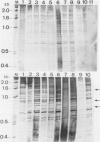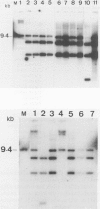Abstract
This study was undertaken to assess the discriminatory value of restriction endonuclease fingerprinting (REF) analysis and ribotyping of 21 Serpulina hyodysenteriae isolates of serotypes 8 and 9. For REF analysis, DNAs were digested with the BglII restriction enzyme and the resultant fragments were separated by polyacrylamide gel electrophoresis. For ribotyping, hybridization of BglII genomic fragments with a probe of rrnB operon using an Escherichia coli rDNA probe was performed on all isolates. Although many isolates shared a common pattern by BglII REF and BglII ribotyping analysis, differences among some S. hyodysenteriae isolates were observed. REF and ribotyping using BglII restriction enzyme, were not specific for serotypes. The predominance of an REF and a ribotype pattern among S. hyodysenteriae isolates from Quebec suggested that epidemiologically important S. hyodysenteriae types occur in different swine herds.
Full text
PDF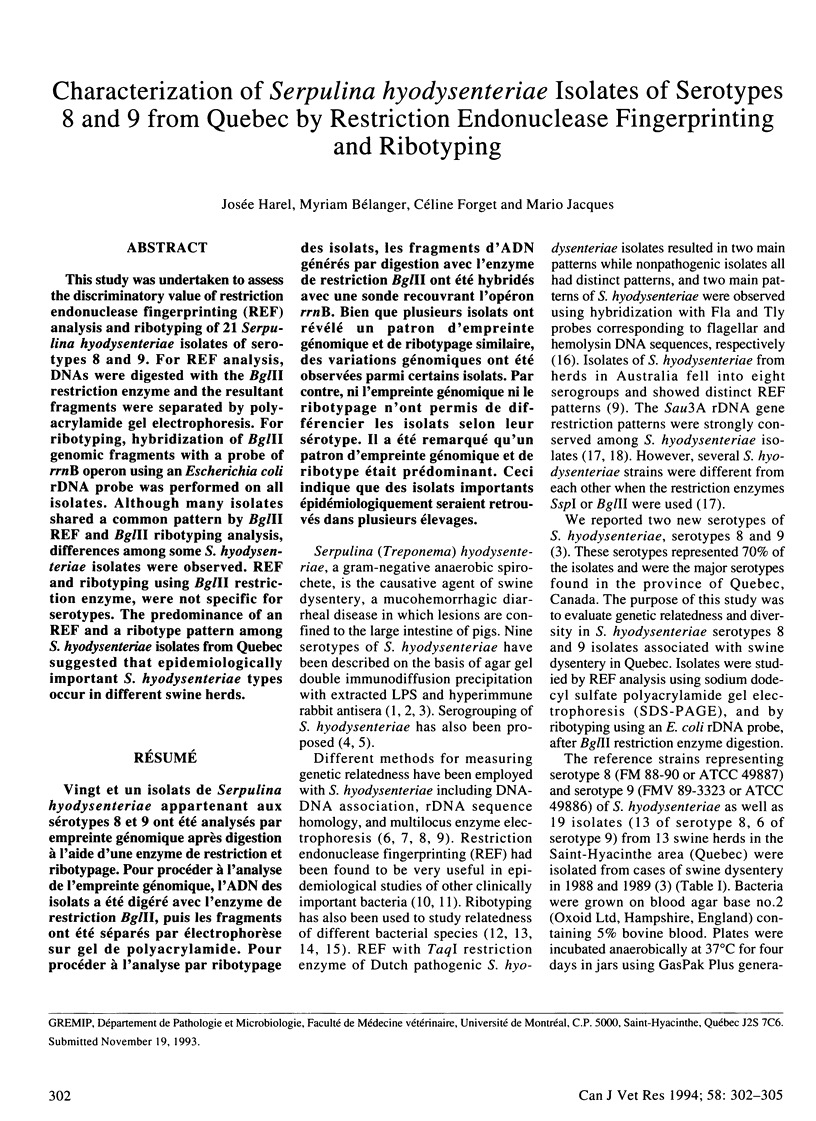
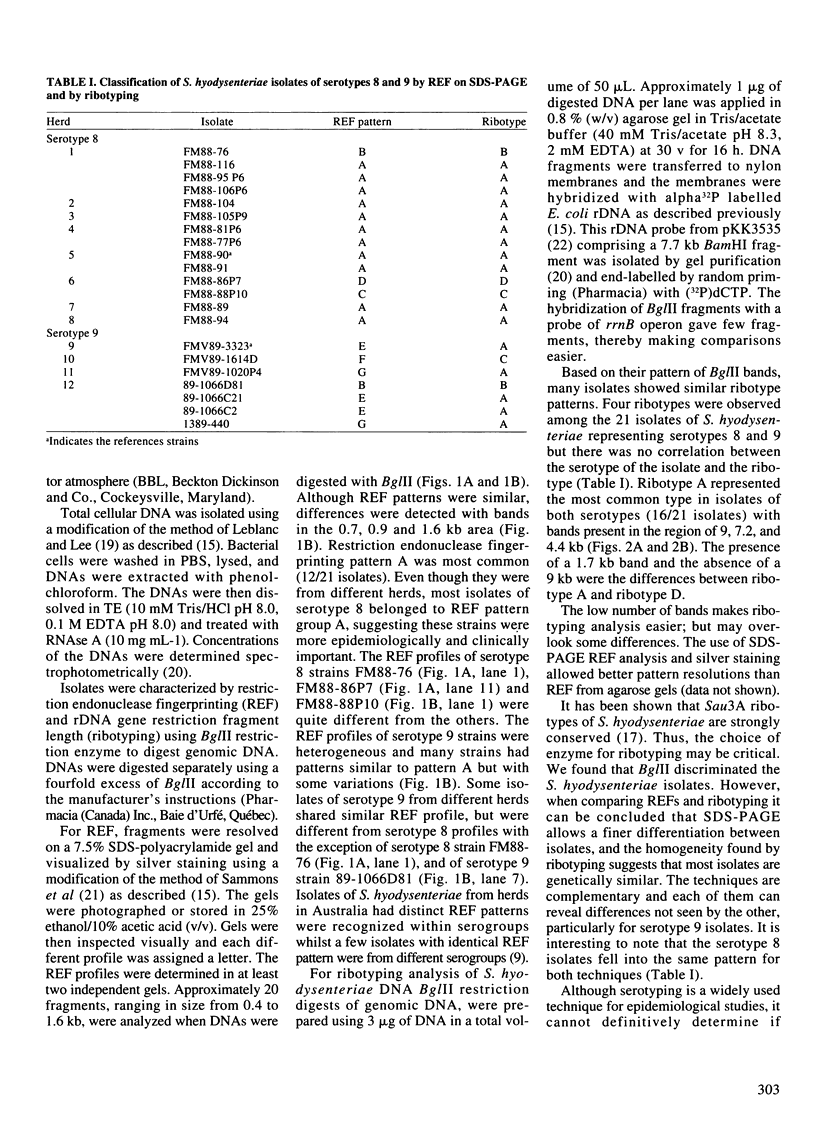
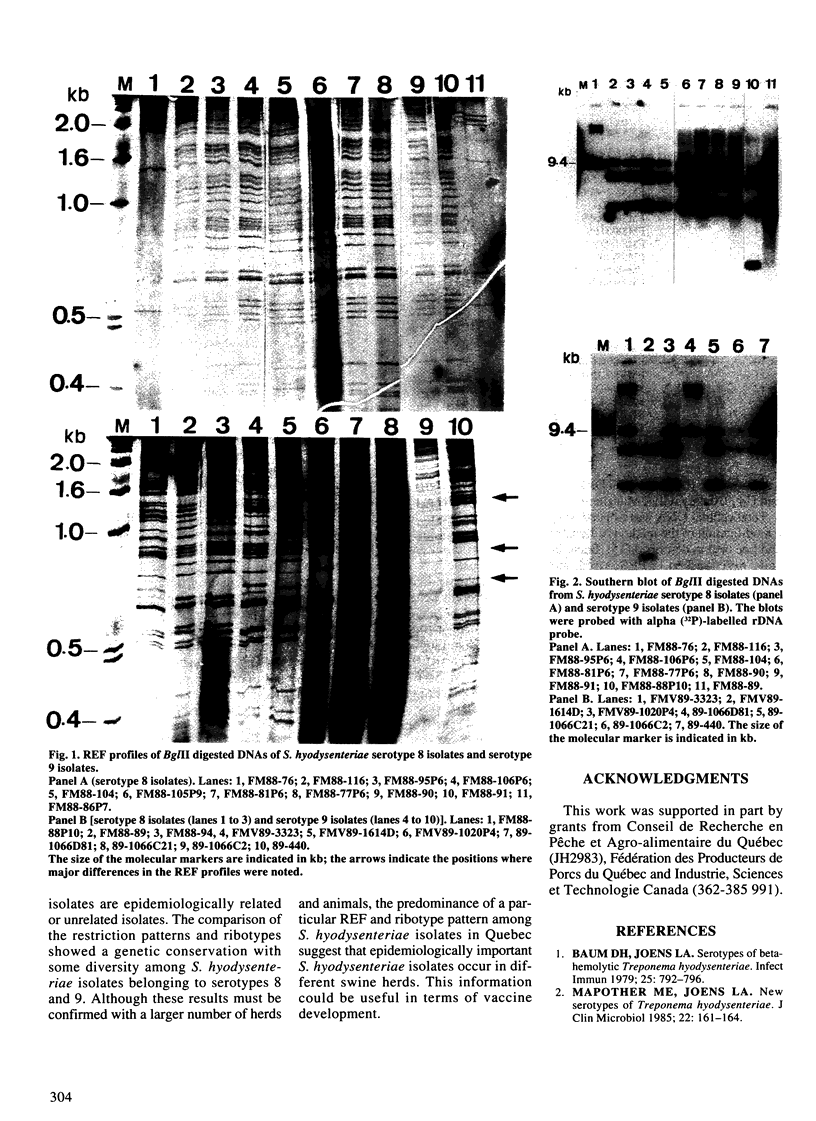
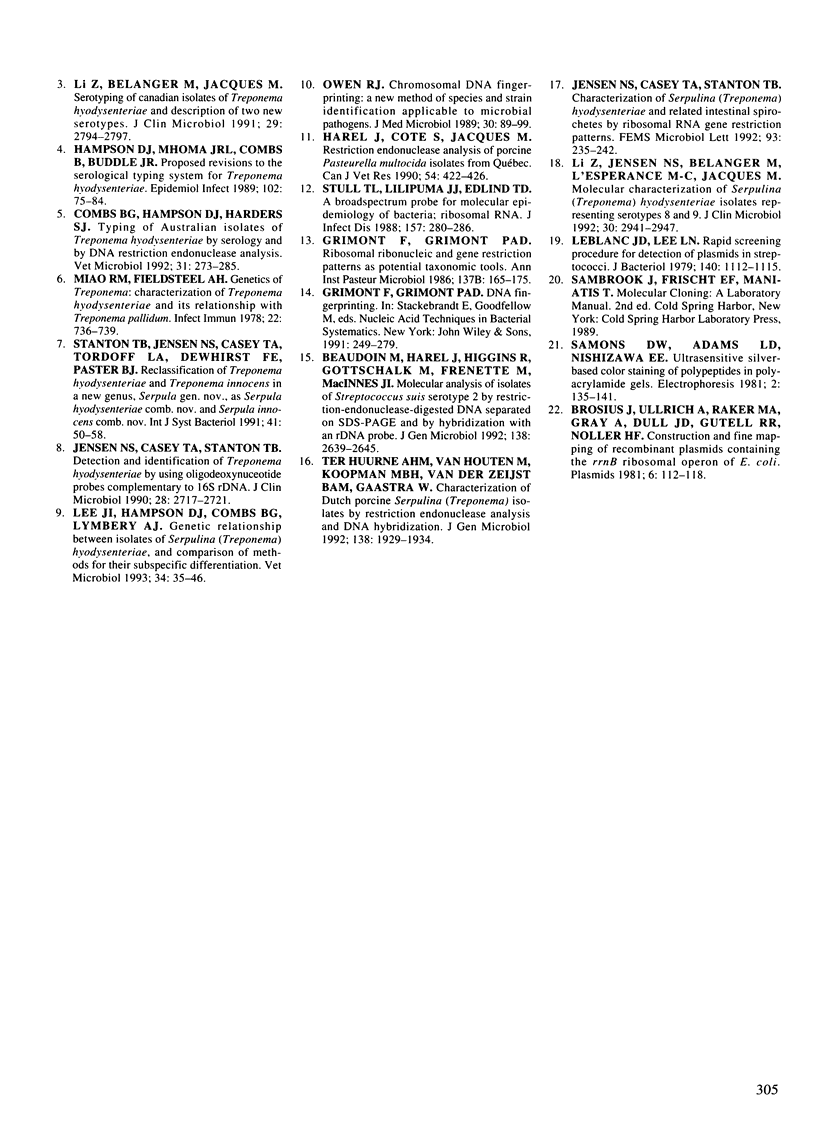
Images in this article
Selected References
These references are in PubMed. This may not be the complete list of references from this article.
- Baum D. H., Joens L. A. Serotypes of beta-hemolytic Treponema hyodysenteriae. Infect Immun. 1979 Sep;25(3):792–796. doi: 10.1128/iai.25.3.792-796.1979. [DOI] [PMC free article] [PubMed] [Google Scholar]
- Beaudoin M., Harel J., Higgins R., Gottschalk M., Frenette M., MacInnes J. I. Molecular analysis of isolates of Streptococcus suis capsular type 2 by restriction-endonuclease-digested DNA separated on SDS-PAGE and by hybridization with an rDNA probe. J Gen Microbiol. 1992 Dec;138(12):2639–2645. doi: 10.1099/00221287-138-12-2639. [DOI] [PubMed] [Google Scholar]
- Brosius J., Ullrich A., Raker M. A., Gray A., Dull T. J., Gutell R. R., Noller H. F. Construction and fine mapping of recombinant plasmids containing the rrnB ribosomal RNA operon of E. coli. Plasmid. 1981 Jul;6(1):112–118. doi: 10.1016/0147-619x(81)90058-5. [DOI] [PubMed] [Google Scholar]
- Combs B. G., Hampson D. J., Harders S. J. Typing of Australian isolates of Treponema hyodysenteriae by serology and by DNA restriction endonuclease analysis. Vet Microbiol. 1992 Jun 1;31(2-3):273–285. doi: 10.1016/0378-1135(92)90085-8. [DOI] [PubMed] [Google Scholar]
- Grimont F., Grimont P. A. Ribosomal ribonucleic acid gene restriction patterns as potential taxonomic tools. Ann Inst Pasteur Microbiol. 1986 Sep-Oct;137B(2):165–175. doi: 10.1016/s0769-2609(86)80105-3. [DOI] [PubMed] [Google Scholar]
- Hampson D. J., Mhoma J. R., Combs B., Buddle J. R. Proposed revisions to the serological typing system for Treponema hyodysenteriae. Epidemiol Infect. 1989 Feb;102(1):75–84. doi: 10.1017/s0950268800029708. [DOI] [PMC free article] [PubMed] [Google Scholar]
- Harel J., Côté S., Jacques M. Restriction endonuclease analysis of porcine Pasteurella multocida isolates from Quebec. Can J Vet Res. 1990 Oct;54(4):422–426. [PMC free article] [PubMed] [Google Scholar]
- Jensen N. S., Casey T. A., Stanton T. B. Characterization of Serpulina (Treponema) hyodysenteriae and related intestinal spirochetes by ribosomal RNA gene restriction patterns. FEMS Microbiol Lett. 1992 Jun 15;72(3):235–241. doi: 10.1016/0378-1097(92)90468-4. [DOI] [PubMed] [Google Scholar]
- Jensen N. S., Casey T. A., Stanton T. B. Detection and identification of Treponema hyodysenteriae by using oligodeoxynucleotide probes complementary to 16S rRNA. J Clin Microbiol. 1990 Dec;28(12):2717–2721. doi: 10.1128/jcm.28.12.2717-2721.1990. [DOI] [PMC free article] [PubMed] [Google Scholar]
- Leblanc D. J., Lee L. N. Rapid screening procedure for detection of plasmids in streptococci. J Bacteriol. 1979 Dec;140(3):1112–1115. doi: 10.1128/jb.140.3.1112-1115.1979. [DOI] [PMC free article] [PubMed] [Google Scholar]
- Lee J. I., Hampson D. J., Combs B. G., Lymbery A. J. Genetic relationships between isolates of Serpulina (Treponema) hyodysenteriae, and comparison of methods for their subspecific differentiation. Vet Microbiol. 1993 Jan;34(1):35–46. doi: 10.1016/0378-1135(93)90005-r. [DOI] [PubMed] [Google Scholar]
- Li Z. S., Bélanger M., Jacques M. Serotyping of Canadian isolates of Treponema hyodysenteriae and description of two new serotypes. J Clin Microbiol. 1991 Dec;29(12):2794–2797. doi: 10.1128/jcm.29.12.2794-2797.1991. [DOI] [PMC free article] [PubMed] [Google Scholar]
- Li Z., Jensen N. S., Bélanger M., L'Espérance M. C., Jacques M. Molecular characterization of Serpulina (Treponema) hyodysenteriae isolates representing serotypes 8 and 9. J Clin Microbiol. 1992 Nov;30(11):2941–2947. doi: 10.1128/jcm.30.11.2941-2947.1992. [DOI] [PMC free article] [PubMed] [Google Scholar]
- Mapother M. E., Joens L. A. New serotypes of Treponema hyodysenteriae. J Clin Microbiol. 1985 Aug;22(2):161–164. doi: 10.1128/jcm.22.2.161-164.1985. [DOI] [PMC free article] [PubMed] [Google Scholar]
- Miao R. M., Fieldsteel A. H., Harris D. L. Genetics of Treponema: characterization of Treponema hyodysenteriae and its relationship to Treponema pallidum. Infect Immun. 1978 Dec;22(3):736–739. doi: 10.1128/iai.22.3.736-739.1978. [DOI] [PMC free article] [PubMed] [Google Scholar]
- Owen R. J. Chromosomal DNA fingerprinting--a new method of species and strain identification applicable to microbial pathogens. J Med Microbiol. 1989 Oct;30(2):89–99. doi: 10.1099/00222615-30-2-89. [DOI] [PubMed] [Google Scholar]
- Stanton T. B., Jensen N. S., Casey T. A., Tordoff L. A., Dewhirst F. E., Paster B. J. Reclassification of Treponema hyodysenteriae and Treponema innocens in a new genus, Serpula gen. nov., as Serpula hyodysenteriae comb. nov. and Serpula innocens comb. nov. Int J Syst Bacteriol. 1991 Jan;41(1):50–58. doi: 10.1099/00207713-41-1-50. [DOI] [PubMed] [Google Scholar]
- Stull T. L., LiPuma J. J., Edlind T. D. A broad-spectrum probe for molecular epidemiology of bacteria: ribosomal RNA. J Infect Dis. 1988 Feb;157(2):280–286. doi: 10.1093/infdis/157.2.280. [DOI] [PubMed] [Google Scholar]
- ter Huurne A. A., van Houten M., Koopman M. B., van der Zeijst B. A., Gaastra W. Characterization of Dutch porcine Serpulina (Treponema) isolates by restriction endonuclease analysis and DNA hybridization. J Gen Microbiol. 1992 Sep;138(9):1929–1934. doi: 10.1099/00221287-138-9-1929. [DOI] [PubMed] [Google Scholar]



